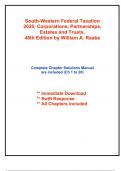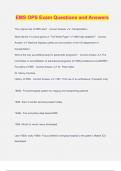South-Western Federal Taxation
2025, Corporations, Partnerships,
Estates and Trusts,
48th Edition by William A. Raabe
Complete Chapter Solutions Manual
are included (Ch 1 to 20)
** Immediate Download
** Swift Response
** All Chapters included
,Table of Contents are given below
1. Understanding and Working with the Federal Tax Law.
2. The Deduction for Qualified Business Income for Noncorporate Taxpayers.
3. Corporations: Introduction and Operating Rules.
4. Corporations: Organization and Capital Structure.
5. Corporations: Earnings & Profits and Dividend Distributions.
6. Corporations: Redemptions and Liquidations.
7. Corporations: Reorganizations.
8. Consolidated Tax Returns.
9. Taxation of International Transactions.
10. Partnerships: Formation, Operation, and Basis.
11. Partnerships: Distributions, Transfer of Interests, and Terminations.
12. S Corporations.
13. Comparative Forms of Doing Business.
14. Taxes in the Financial Statements.
15. Exempt Entities.
16. Multistate Corporate Taxation.
17. Tax Practice and Ethics.
18. The Federal Gift and Estate Taxes.
19. Family Tax Planning.
20. Income Taxation of Trusts and Estates.
,Solutions Manual organized in reverse order, with the last chapter
displayed first, to ensure that all chapters are included in this document.
(Complete Chapters included Ch20-1)
Solution and Answer Guide
NELLEN, YOUNG, CRIPE, LASSAR, PERSELLIN, CUCCIA, SWFT CORPORATIONS, PARTNERSHIPS,
ESTATES & TRUSTS 2025, 9780357989074;
CHAPTER 20: INCOME TAXATION OF TRUSTS AND ESTATES
TABLE OF CONTENTS
Discussion Questions ...........................................................................................................1
Computational Exercises ................................................................................................... 4
Problems ............................................................................................................................. 5
Research Problems ............................................................................................................13
Check Figures.................................................................................................................... 14
Solutions To Ethics & Equity Features ..............................................................................15
Solutions To Becker CPA Review Questions ....................................................................15
Tax Return Problems ........................................................................................................ 19
DISCUSSION QUESTIONS
1. (LO 1) Taxpayers create trusts for a variety of reasons. Some trusts are established
primarily for tax purposes, and others are designed to accomplish a specific
financial goal or to provide for the orderly management of assets in case of an
emergency. The most commonly encountered reasons for creating a fiduciary entity
include the following:
• To hold life insurance policies on the decedent as part of an estate plan to
remove such policies from the gross estate.
• To manage assets, reduce probate costs, and ensure the privacy of the
distribution of assets near the end of the grantor’s life.
• To provide funds for an advanced education, accumulating income at a lower
tax rate than the grantor.
• To manage the assets of a divorcing couple in an objective manner.
2. (LO 1) Each of the entities is taxed differently under Federal income tax law.
a. C corporations are separate taxable entities distinct from their shareholders.
See Chapters 3 to 6.
b. Partnerships are pass-through entities and never incur Federal income tax
liabilities. See Chapters 9 and 10.
, c. S corporations are pass-through entities and incur Federal income tax liabilities
only rarely (e.g., built-in gains tax penalty or for the tax on excessive passive
investment income). See Chapter 11.
d. Trusts and estates are modified pass-through entities and incur Federal
income tax when taxable income is retained by the entity, rather than
distributed from taxable amounts to income beneficiaries.
3. (LO 1)
a. All income is required to be distributed currently to the granddaughter of the
grantor. No corpus distributions are made.
b. All income is required to be distributed currently to State University, a qualifying
charity. No corpus distributions are made.
c. Income can be sprinkled at the discretion of the trustee; or same as part a. or b.,
except that a corpus distribution is made during the year.
4. (LO 2) With respect to a distribution of appreciated property by a fiduciary, no gross
income generally is recognized by the entity. Basis of the asset carries over to the
recipient. DNI and the distribution deduction reflect an amount for the distribution
equal to the lesser of the asset’s basis or its fair market value.
DNI and distribution deduction $80,000
Gross income to Liu –0–
Basis to Yang 80,000
Upon making a § 643(e) election, though, the distribution can become a taxable event
to the entity. The gain is recognized by the fiduciary, and the beneficiary takes a basis
in the asset equal to its fair market value. Both DNI and the distribution deduction
would reflect the asset’s fair market value.
DNI and distribution deduction $100,000
Gross income to Liu 20,000
Basis to Yang 100,000
5. (LO 2) The default application of the deduction for administrative fees is to the estate
tax return. Code § 212 expenses of this sort are deductible on an income tax return
only if a waiver of the estate tax deduction is filed.
Here, the deduction is more valuable on the estate tax return, where the marginal
tax rate is higher. So the fees should be fully assigned to the Form 706.
6 . (LO 2) Cost recovery deductions related to the assets of a fiduciary are assigned
proportionately among the recipients of entity accounting income.
Mona deducts on her Form 1040 depreciation attributable to Sterling of $20,000
[$100,000 × ($500,000 ÷ $2,500,000)]. The beneficiaries’ shares of gross, taxable, and
distributable net income are irrelevant for this purpose.
7. (LO 2) If the charitable gift is determinable in both existence and amount to the
controlling will or trust agreement, the entity is allowed a deduction for the amount
of the gift that is paid from current-year gross income. See § 265 for disallowance
possibilities.





